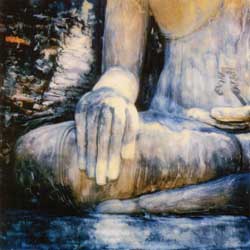 Technology has triumphed, and the debate over its use in art is over. But the victory for technology didn't come quickly or easily, it took years of redefining the meaning of \'art'. Dadaist Marcel Duchamp, who shocked the European art world with an exhibit that was simply an inverted commode, futurist Fillipo Marinetti, who apotheosised technology; the king of kitsch Andy Warhol, who created art out of discarded cans-they all helped broaden and redefine the meaning of art, eventually leading to the acceptance of technology in art. But all that, even if some of it happened some 80 years ago, hadn't really touched Nepal. Until now.
Technology has triumphed, and the debate over its use in art is over. But the victory for technology didn't come quickly or easily, it took years of redefining the meaning of \'art'. Dadaist Marcel Duchamp, who shocked the European art world with an exhibit that was simply an inverted commode, futurist Fillipo Marinetti, who apotheosised technology; the king of kitsch Andy Warhol, who created art out of discarded cans-they all helped broaden and redefine the meaning of art, eventually leading to the acceptance of technology in art. But all that, even if some of it happened some 80 years ago, hadn't really touched Nepal. Until now. US-based artist Jyoti Duwadi's exhibition of computer-aided paintings, which he calls digital prints, at the Siddhartha Art Gallery should be of interest to Nepali audiences. There are altogether eleven paintings done in three different styles on display-the difference in style being the difference in the programs used to \'paint' or generate the artworks.
The interesting thing about technology-aided art like Duwadi's is that the possibilities seem endless. Take, for example, the painting titled Desert. Here the artist has superimposed one photographic image over another. Then he has distorted and manipulated the images to create a painting in which one can see, quite clearly, a forest receding in the background in the upper half and, not so clearly, figures in sombre attitudes veiled by what look like optical threads in the lower half. In other paintings, instead of working on the images available to him, Duwadi has created images that are purely abstract. On account of this, try as one might, it is difficult for the viewer to relate them to everyday reality. So one looks for aesthetic beauty in these images, and there one runs into another matter. Possibly because we are used to conventional paintings and colours, the images and their colours, while nice to look at, don't really strike a chord. Digital prints seem to lack that immediacy of colour and texture that conventional paintings have. Perhaps this is why the painting called Earth Drawing, though rather-a few lines drawn unaided by the computer-has a different, more appealing feel than the rest of the paintings.
Also on display at the Siddhartha Art Gallery is the work of Sandy Shum, a photographer from Thailand. Shum likes to call her work impressionistic photographs and, like Jyoti Duwadi's paintings, her photographs will be new to a Nepali audience. Shum has mainly photographed sculptures of the Buddha, Swoyambu temple, gongs, bells and the windhorses-coloured pieces of cloth printed with Buddhist texts-that we see festooned around gompas. The subjects seems ordinary. But Shum's photographs are anything but.
She forgoes the idea of photographic reality and subverts the very essence of photography-that of capturing a subject precisely, in its finely detailed glory. Instead, they are rather characterised by vague, blurred lines and textures, very much like those in impressionist paintings. Some of Shum's subjects have hard, bone-like feel, similar to mixed media painting that uses adhesive. How she achieves this is simple-Shum presses a rounded nub of a special kind of pen against the Polaroid of a photograph and then prints it to get different textures. The process demands creativity, however-particularly in deciding what texture suits which surface.
Shum's photographs are different, no doubt. But are they beautiful? More beautiful than they would have been without being manipulated in Polaroid? This reviewer has his reservations.
The work of Jyoti Duwadi and Sandy Shum is on view at the Siddhartha Art Gallery until 26 November, 11AM-6PM, Sunday through Friday.


